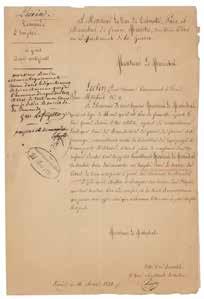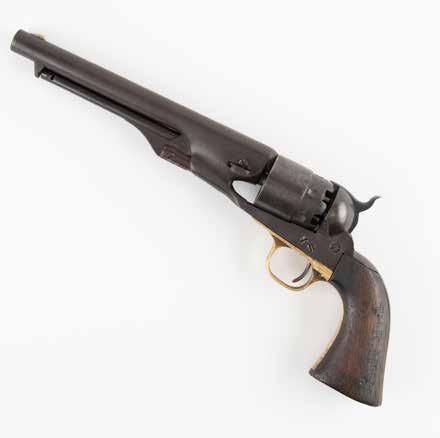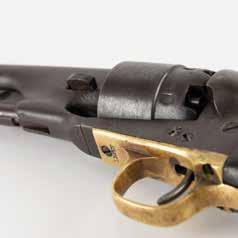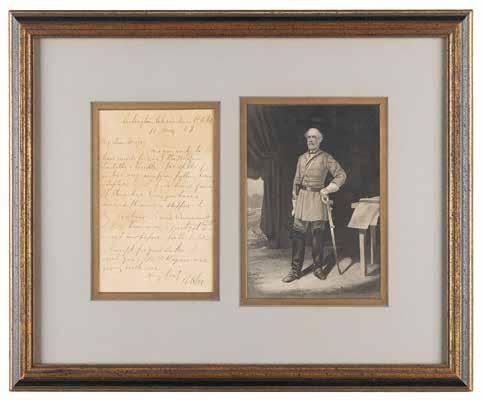
7 minute read
Military
321. Marquis de Lafayette Document Signed. Manuscript DS in French, signed
“Lafayette,” one page, 8.5 x 12.5, March 1831. Untranslated document endorsed in the left margin by Gilbert du Motier, Marquis de Lafayette, below an endorsement by his son, Georges Washington de La Fayette. In fine condition. Starting Bid $200
323. Joshua Lawrence Chamberlain Signature. Crisp
ink signature, “Very truly yours, Joshua L. Chamberlain, Brunswick, March 15, 1880,” on an off-white 6.75 x 4 album page. In fine condition. Starting Bid $200


322. USS Constitution 1927 Renovation Wood Mallet. Mallet constructed of wood removed from the hull of the USS Constitution during the frigate’s historic 1927 restoration, measuring 11.5˝ long with a 2˝ x 1.5˝ x 3.25˝ head, with a descriptive plate reading: “This material was removed from the U.S. Frigate Constitution during Reconstruction, 1927.” In very good to fine condition, with some verdigris and heavy patina to the plate and bands on the mallet head; one of the bands has popped open and is somewhat loose. A desirable and uncommon souvenir format from the historic 1927 renovation of ‘Old Ironsides.’ Starting Bid $200




Colt Model 1860 Army revolver capture by a Confederate trooper, plus his knife and belt rig

324. Civil War: Colt Revolver and Accessories Belonging to Private James R. Hanna, Co. B, 9th Battalion, Tennessee Cavalry (Gantt’s). Splendid grouping
of Civil War items belonging to Private James R. Hanna, a trooper in Lt. Colonel George Gantt’s battalion of Tennessee volunteer cavalry, consisting of a Colt Model 1860 Army revolver, wrought iron bowie knife, and belt rig. The revolver is serial #112697 in .44 Caliber, with an 8” barrel having a very good bore that has some dark pitting within the grooves. The revolver has all-matching numbers, including the wedge and cylinder arbor, with the metal having an overall plum-brown patina with thin, pinprick pitting evenly distributed across the entire surface. The brass trigger guard has a pale yellow-ochre patina with dark brown mottling in spots as well. The walnut grip is worn but is in very good shape overall. Additionally, a visible, but illegible, U.S. inspector’s cartouche is present at the butt on the left side. Also present on the left side is Hanna’s name carved in a neat mixture of block capitals and script: “Jas. R. Hanna.” According to Colt records, this revolver was one of 1,000 shipped to the U.S. Arsenal on Governor’s Island, NY, on April 23, 1863, and was captured by Hanna sometime after that. The lock-up and timing are good, and the action is fully functional. Starting Bid $1000
As secessionist sympathies grow, the future rebel president corresponds with West Point’s chaplain

325. Jefferson Davis Signed Free Frank. Hand-addressed
and free-franked mailing envelope, 5.25 x 3, addressed by Davis to “Revd. J.W. French, U.S. Mil. Academy, West Point, New York,” and franked in the upper right, “Jeffer. Davis, USS.” In very good to fine condition, with a tear through the top of Davis’s franking signature caused by the recipient. John W. French served as chaplain of the House of Representatives from 1841 until 1856, when he was appointed Chaplain and Professor of Geography, History, and Ethics at the Military Academy at West Point by President Franklin Pierce. He was notified of his appointment by Pierce’s Secretary of War, Jefferson Davis, and they remained lifelong friends. This friendship caused some to question French’s loyalty at the outbreak of the Civil War. Also included is a bound manuscript copy of a document in which J. W. French attests to his devotion to the Union. Starting Bid $200
Choice twice-signed letter regarding a West Point professorship


326. Jefferson Davis Autograph Letter Signed Twice. Bold ALS signed twice, “Jeffer. Davis,” one page both sides, 7.75 x 9.75, August 26, 1856. Handwritten letter to John W. French, forwarding the “application of Mr. Sprole to the Engt. bureau” with “a copy of the endorsement.” Signed below by Davis, who pens a copy of his endorsement: “The period asked for being indefinite I think it proper to say that the duties of the Professor would not permit him for more than a very short period to have less than the undivided possession of his quarters, and the interest of the Academy being paramount it is deemed better that the application should be decided by the Superintendent than be left to the generosity and kindness of the Professor.” This is also signed at the conclusion. In fine condition. Starting Bid $200
Lee orders a saddle months prior to quelling John Brown’s insurrection
327. Robert E. Lee Autograph
Letter Signed. ALS signed “R. E. Lee,” one page, 4.75 x 7.25, May 10, 1859. Addressed from Arlington in Alexandria County, Virginia, a handwritten letter to Major P. V. Hagner, in full: “Are you ready to have made for me the uniform saddle & bridle I’ve spoke of or has any uniform pattern been adopted—I have heard of none. If there has, can you have a nice sett made & shipped to San Antonio conveniently. I have been away & just got back & must now prepare for the field. Except for your sakes I wish you & Mrs. Hagner were going with me.” Attractively double-matted and framed with an engraving to an overall size of 19.25 x 15.25. In very good to fine condition, with light staining not at all affecting readability. Starting Bid $300


329. Horatio Nelson: HMS Victory Wooden Artifact. Desir-
able barrel-shaped matchstick holder, measuring 2.25˝ tall and 1.75˝ in diameter, crafted from wood removed from the bowsprit from Horatio Nelson’s flagship, the HMS Victory. A metal identification plaque on the front reads: “From the Bowsprit of HMS Victory, (Nelson’s Flagship Trafalgar 1805), Purchased 2nd June 1937.” In fine condition, with some scattered dings to exterior. Starting Bid $200


Exceedingly rare, early letter by the 16-year-old “Napolione di Buonapart,” a newly commissioned French artillery lieutenant
328. Napoleon Autograph Letter Signed. ALS in
French, signed “Napolione di Buonapart,” three pages on two adjoining sheets, 6.25 x 7.75, November 25, 1785. One of the earliest known autograph letters of Napoleon Bonaparte, written to “l’abbé Amielh,” school principal at the “séminaire d’Aix-en-Provence.” In 1784, Napoleon was admitted to the École Militaire in Paris. He trained to become an artillery officer and, when his father’s death in 1785 reduced his income, was forced to complete the two-year course in one year. He was the first Corsican to graduate from the École Militaire. At just sixteen years old, Napoleone di Buonaparte was appointed second lieutenant in the artillery regiment of La Fère barracks in Valence on September 1, 1785.
Young Napoleon thanks “l’abbé” for his consideration and points out: “I don’t understand how my dear parents could have been worried for a moment.” He describes his situation, living in Paris with Louis-Charles-René de Marbeuf, then French governor of Corsica, linked to the Bonaparte. His brother, Napoleon continues, cannot be raised in Aix-en-Provence and therefore has to remain in Brienne. He continues that he had an order to join the regiment in Valence, where he had been for three weeks. He mentions his uncle, the cardinal Joseph Fesch, who fulfilled the role as protector of the Bonaparte family for some years. Napoleon points out that his semester doesn’t start until September, “for then, Sir, I will be happy to have the pleasure of getting to know a man for whom I already take the keenest interest”—l’abbé himself. Addressed on the reverse in Napoleon’s own hand, and affixed by its edge to a larger sheet bound into a handsome full red leather presentation folder. In fine condition, with scattered light staining and soiling. Napoleon would serve in Valence and Auxonne until after the outbreak of the Revolution in 1789. Under the leadership of peré Amielh, the Aix-en-Provence seminary welcomed young Corsicans. Napoleon’s uncle, Joseph Fesch, the half-brother of Letizia Bonaparte and future Archbishop of Lyon and Grand Chaplain of the Empire, studied there from 1781 to 1786. He also intended for Napoleon’s brother Lucien to study there. A remarkable letter by the young Napoleon, boasting a rare variation of his signature. Starting Bid $5000









